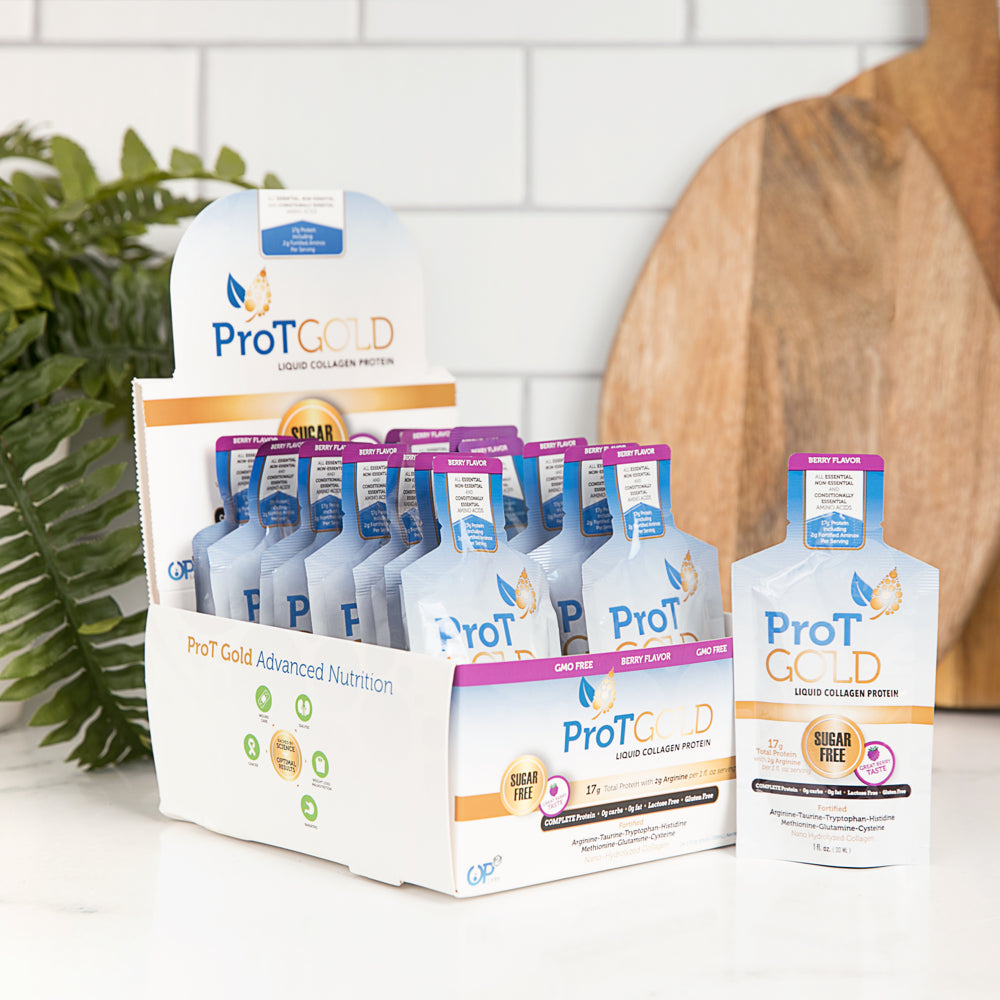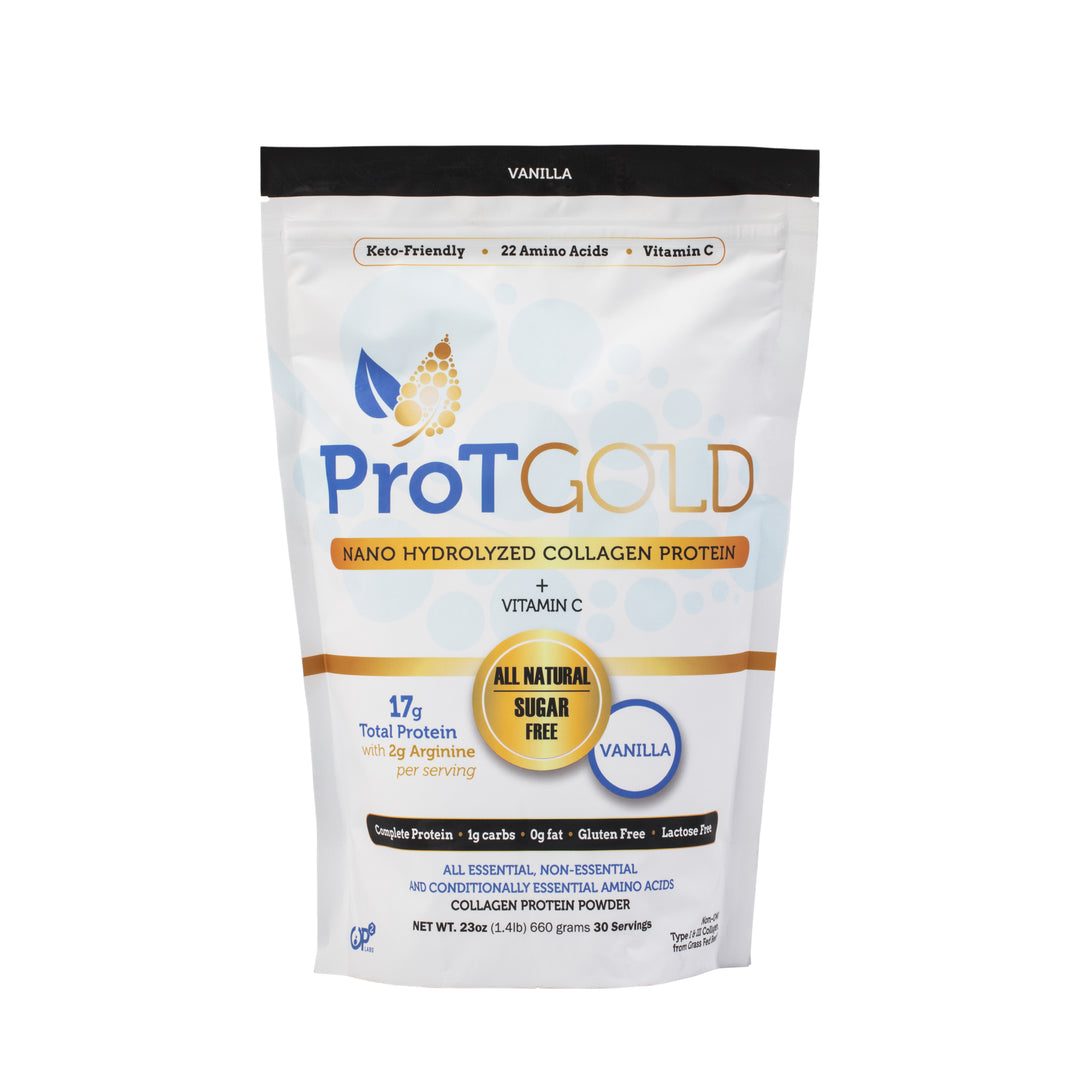How Is Medical-Grade Collagen Made and Tested?
If you have some interest in how collagen is made, you’re probably aware of some of the positive benefits of this incredible supplement. But not all collagen supplements are created equal, and most are not medical-grade. So how is collagen made?
Specifically, what is the process creating and testing our medical-grade, nano-hydrolyzed collagen?
Answering the question “how is collagen made?” is not always simple. How collagen is made has a lot to do with the type of collagen it is, the intended use of the collagen protein, and how much science goes into the process.
We will explore not only the question “how is collagen made,” but how medical-grade collagen is made, and what collagen is best for you. But first, we must first discuss exactly what collagen is.
What is collagen?
Collagen protein is the most abundant protein in the human body, and it makes up 25-35% of the total protein found in your body.
It is a major insoluble fibrous protein, and is so abundant because it serves as the primary building block of your connective tissues (i.e., skin, muscles, ligaments, etc.).
So, what is collagen?
Collagen proteins, like other proteins, are actually composed of amino acids. Three chains of over 1,000 amino acids are used to create collagen, with the most important being prolin, hydroxyproline, and glycine.
Because collagen is a protein, we are often asked: Is collagen vegan?
No, collagen is not vegan. Although there are “vegan collagen” supplements on the market, these are simply collagen boosters and they don’t contain any actual collagen protein.
All collagen supplements on the market come from an animal source of some kind. That’s because collagen protein is a structural protein in the connective tissues of all mammals. Most collagen supplements are derived from cows, pigs, or chickens.
There are a wide variety of collagen supplements on the market, but they all are derived from the same protein and amino acid complex. No matter the exact type of collagen within a supplement, it is all built from amino acids.
What are the most common collagen supplements?
There are an estimated 16 types of collagen in existence, but 80-90% of the collagen found in animals is type 1, 2, and 3. Those are also the types of collagen most often used in collagen supplements.
While collagen in the natural form can be used in supplements (i.e., bone broth), that isn’t the most effective way to consume collagen.
That’s why the large majority of collagen supplements you’ll find on the market are either hydrolyzed (collagen peptides) or nano-hydrolyzed. It is more common to see hydrolyzed collagen than nano-hydrolyzed, but their processing is very similar.
How collagen is made may differ depending on the intended use of the protein. For instance, you can get collagen supplements in the form of:
- Topical creams
- Capsules
- Powders
- Liquid
How collagen is made for a topical cream will most likely be different than how collagen is made for internal ingestion. The ingredients and processing of each particular supplement may vary as well depending on the molecule size or any flavorings added.
There are also many medical uses of collagen. While liquid collagen supplements have some uses in medical nutrition therapy, collagen is also used in collagen wound dressings. A wound dressing will have a different composition than a digestible supplement.
Since there are so many different types and forms of collagen, how collagen is made can absolutely differ to some degree.
What collagen is best?
What collagen is best for you is often determined by the intended use and your specific health goals. Since medical-grade collagen can be prescribed for medical purposes, how that collagen is made may also differ from other collagen you find at your local grocery store.
Determining which collagen is best for you not only includes looking at the intended use, but the absorption rate. The absorption rate of any nutrient is essentially defined as how fast your body absorbs, processes, or digests what you’ve consumed.
So, which collagen has the best absorption rate?
Nano-hydrolyzed collagen is likely the best collagen as far as absorption rate is concerned. After that would be hydrolyzed collagen or collagen peptides.
When collagen is in the whole form, the molecule size is too large to pass through your stomach pores. This means you end up passing most of those important amino acids, rendering the supplement a waste.
To help your body break down the amino acids after you’ve consumed collagen, the process of hydrolysis comes into play. Hydrolysis breaks the molecules down into smaller, more digestible sizes so you can more easily absorb the nutrients.
How is collagen made in the hydrolyzed form?
Since collagen is a family of proteins made up of amino acids, when collagen is used as a supplement, the protein needs to be broken down into polypeptide chains.
Polypeptide chains are more simply described as a peptide (short chain of amino acids) consisting of two or more amino acids. The polypeptide in this instance is hydrolyzed collagen, which is also known as collagen peptides.
How collagen is made in the hydrolyzed and nano-hydrolyzed form is through the process of hydrolysis.
The reason denatured collagen needs to go through this process is to help it be more absorbable and so it does not turn to gel while retaining surface-active properties. The majority of collagen that goes through this process is type 1 collagen because it is often used as gelatin.
Where the collagen is sourced from depends on the type of collagen used. For instance, most type 1 collagen would be sourced from bovine, pig, or marine sources. However, you can also extract type 3 collagen from bovine and marine sources as well.
Type 2 collagen is often collected from chicken sternum cartilage.
Whatever the source of the collagen, how collagen is made into hydrolyzed collagen generally follows the same process.
The processing of the raw collagen so it can become hydrolyzed or nano-hydrolyzed collagen follows the following steps:
- Collection of raw collagen
- Chemical breakdown
- pH adjustment
- Extraction to turn collagen into gelatin
- Enzymatic hydrolysis
- Ion exchange
- Filtration
- Evaporation and sterilization
- Spray drying
- Resulting in hydrolyzed collagen
Knowing those standard steps is all good and well, but that might still have you wondering… how is collagen made?
Collagen is a very sturdy protein structure, which is why many manufacturers need to either turn it into gelatin or start with gelatin in the first place. The beginning steps in making hydrolyzed collagen are simply extracting collagen from an animal source and turning it into gelatin.
One common source of collagen protein is animal bones, specifically bovine bones. When using this source for collagen, manufacturers soak the bones with acid to demineralize them and create a brittle material that is easier to work with. This is called ossein.
Once the ossein is made, they need to remove any impurities and neutralize the pH. To do this, manufacturers simply wash the ossein with water. Then, to make the collagen into gelatin or to make it water soluble, they will subject it to a secondary acid treatment and hot water wash.
If manufacturers choose to source from animal skin or hide, there may be fewer steps to get to a gelatin or water-soluble collagen.
From here, they can begin the hydrolysis process.
Enzymatic hydrolysis is done with water. It is the breakdown of the specified compound, in this case collagen, in the presence of enzymes following a reaction with water.
It is also possible to go through this process using a chemical hydrolysis, but most manufacturers prefer the use of enzymatic hydrolysis because it allows for better control. A combination of the two may also be used in order to reach the desired molecular weight.
The molecular weight of hydrolyzed collagen is perhaps the most important factor in the production process when discussing the desired functional properties.
While the process listed above is standard, it can also utilize advanced membrane filtration techniques to fractionate the collagen during the separation process. When using this membrane, it can reduce the energy required and save some water through recycling.
Whatever process they choose to use for hydrolysis, the end result is hydrolyzed collagen. Once the manufacturer has obtained the hydrolyzed collagen, then it must be filtered, sterilized, and dried (if it is powder).
But how is collagen made from a hydrolyzed or nano-hydrolyzed supplement into a medical-grade one? Let’s discuss how medical-grade collagen gets the stamp of approval.
The difference between medical-grade collagen and other collagen supplements
When something is medical grade, it means that the product being offered is only available from establishments that operate under a physician’s license. This means that there must be a medical director for the retailer to sell those products.
Collagen supplements are designated safe for human consumption, and there are many potential medical benefits of collagen. While this may be true, that doesn’t mean that all collagen supplements are medical grade.
To be categorized as medical grade, the product must go through testing for biocompatibility and safety. These tests are conducted by the FDA and involve nutrient and microbial analysis.
Other than lab testing, there are also physical inspections of the manufacturing facilities that include testing to:
- Ensure quality and nutrient content matches what is described on the label
- Identify any possible environmental or microbial contaminants
- Confirm packaging and seal integrity
- Review production and batch records
- Review procedures and records of equipment cleaning, lab controls, returned products, and any complaints filed
Compliance guidelines with the FDA may differ for international versus domestic production and distribution.
If you are looking for medical-grade collagen, you can get a doctor's recommendation. And, if you are someone that a doctor has directed to a dietician for medical nutrition therapy, then you can ask some important questions like:
- What type of collagen should I use?
- Do you have a recommendation for a medical grade collagen?
- Will my insurance cover collagen as a medical supplement?
- Are there any known side effects of using collagen?
- Are collagen supplements safe?
If you are looking on your own accord and simply want to ensure you are getting a high-quality collagen supplement, look for supplements that are categorized as medical grade or a medical food.
These supplements will have gone through clinical testing and will have ongoing case studies to contribute to the preexisting scientific research.
What’s more is that medical-grade collagen supplements, like ProT Gold, often will use a standard food nutrition label versus a supplement label. This type of label makes it easier for the consumer to read and understand what they’re putting into their body.
ProT Gold Liquid Collagen supplements are a medical-grade nano-hydrolyzed collagen protein. They’ve been approved by the FDA and are a ready-to-drink supplement designed by a Stanford biochemist.
If you have any concern or questions over how collagen is made or what collagen supplements are best for you, know that our high-quality collagen protein is recommended by nearly 4,000 doctors, nutritionists, and other medical professionals.









